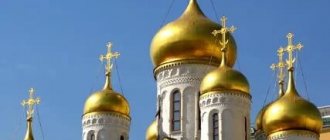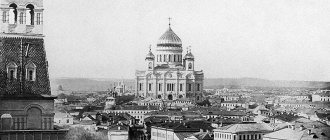A person who is far from religion cannot always answer the question of whether the temple in front of him is a church, or maybe a monastery or a chapel. Often such a gap in knowledge can alienate a person from Orthodoxy, even if there is a desire to visit a holy place. Out of embarrassment of his ignorance, a person may be afraid to enter a holy temple, church.
Therefore, it is so important to understand the significant differences between a temple, church, monastery or chapel, which have their own rules, foundations, traditions, and norms of behavior.
For a non-religious person, a shallow believer, there are no significant differences. Answering a question, he can say that a temple or cathedral is something big, and a church is a little smaller, a monastery is where they take monastic vows.
But this is far from entirely true. In order to understand the issue of differences, it is necessary to go in ascending order.
What is a temple and church, cathedral, monastery, church, mosque, chapel: definition
The most common term is temple.
- Any religious building of any direction can be called a temple. For example, a Muslim mosque, a Catholic church, a cathedral. The word “temple” is a Church Slavonic concept that was formed thanks to the word “mansions”.
- Previously, people called huge, spacious buildings this way. From here the concept of “royal mansions” also arose.
Definition of Church Buildings
Cathedral, church, and chapel are the terms used for Christian places of worship.
- The term "Cathedral" also has Slavic origins. Just listen to how it sounds like “to collect” or “to gather.” In Rus', people also called a cathedral a meeting or congress, when church representatives and representatives of other organizations gathered.
- A cathedral is a large temple. People are also accustomed to calling a temple located on the territory of a city a cathedral.
A chapel is a small building where people pray. There are 2 possible origins of this term:
- The chapel had a bell that rang every 1 hour
- “Hour” is a type of service when prayers were read simultaneously with psalms. These readings were usually called “hours.”
How the term “church” originated, no one can still say for sure. The church is very similar to a cathedral. But they still have some differences.
What are the rules in the chapel and for its creators?
For those who build a chapel, there are essentially two rules (and even then these are not rules in the worldly sense, but self-evident actions).
- consecrate it in honor of some saint. For example, in the Catherine Park in Moscow there is a chapel in honor of Saints Alexander Nevsky and John the Warrior. Prayer services are served there weekly and on the days of remembrance of these saints.
- a cross should be erected on the chapel. We are not talking about the presence of icons inside - this is obvious. Although, how many there should be - there are no rules for this - everything is decided by possibilities.
As for the rest, the chapel can be either from the point of view of architecture or from the point of view of decoration. Another thing is that until recently the architect designing the chapel tried to adhere to the spirit of national traditions. Church buildings are not places for self-expression. Any self-expression or “innovation” in the chapel can ultimately distract the parishioners and the creator of the building from the main purpose. Therefore, they try to make the chapel really, in one way or another, resemble a tiny temple externally, and internally too.
Project of a chapel on Station Square in Barnaul
Some chapels in pre-revolutionary times (and even now) were built according to standard designs. Page from the atlas “Atlas of plans and facades of churches and chapels during buildings in villages” of 1911
Orthodox chapel in Greece. A good example when architecture is completely in tune with the times, but does not destroy the Christian spirit.
It is difficult to talk about rules for parishioners, because they are all dictated either by traditions or by the person’s own attitude to spiritual life. People enter the chapel for one purpose - to pray, to be alone with the spiritual part of themselves. Everything else follows directly from this.
There are no strict rules regarding, say, headscarves for women or shorts for men in the chapel. Although, it would be inappropriate to participate in a prayer service or funeral service in “loose clothing” - for a number of reasons.
What is the difference between a church and a temple: a brief comparison
The church is God's house. A home for chosen people, for the chosen. Therefore, a church is not a building, but a group of people who believe in God. A temple is also a church. The most important part of the temple is the altar. On the altar there is a meal with a throne (the room in which the person praying is located). The sacraments of communion and bloodless sacrifice are performed on the throne.
The difference between a church and a temple
So, let's list the main differences between a temple and a church:
- The term "church" is a broad concept that refers to an architectural structure, plus a collection of several people.
- The term "temple" is a special place where worship is held.
- A Christian temple consists of an altar and an altar.
- Any church is a Christian temple.
- The main city church is called the cathedral.
Church
If we talk about the church, not as an institution of Orthodoxy, then in meaning this concept does not differ from the temple. The temple is considered a common name for many Orthodox buildings.
By calling a church an Orthodox church, a believer will not be mistaken. There are no significant differences between a church and a temple.
Churches are the site of the sacraments, which are performed by the rector, and the most common Orthodox buildings.
It has three parts:
- altar,
- central for parishioners to pray,
- narthex - “vestibule”.
These parts personify Heaven or Paradise (altar), earth (central part) and the sinful land, not yet renewed (narthex).
If the landscape allows, the church is always built with the altar facing east, recalling that the Almighty is the creator, the Sun of the whole world
What is the difference between a temple and a cathedral: a brief comparison
- A temple is a religious building. As a rule, rituals are held in temples. Temples are located all over the world, but they have different names. For example, a Jewish temple is a synagogue ; Muslims call a temple a mosque.
- The cathedral is the main city temple, which plays a major role in the religious life of every person. In addition, the cathedral is the main church, which is located in the monastery.
The difference between a temple and a cathedral
A cathedral and a temple have the following distinctive features:
- A temple is every religious building in which worship is carried out. A cathedral is the name given to the main temple in a town or monastery.
- As for the liturgy, it can be held in the church either every day or exclusively on Sundays. But in the cathedral, liturgy is held every day.
- In cathedrals, only the highest ranks conduct services.
- the cathedral looks more massive and richer than an ordinary temple.
- A temple has only one altar, a cathedral can have several.
Recommended by topic
Ioannovsky Monastery Sretensky Monastery Danilov Monastery Valaam Monastery
In the temple, unlike the chapel, there is an altar, where all the main Sacraments and services are performed, including liturgies. The church has a rector and a parish. It can be not only a separate building, but also a small room attached to the main building, which can perform a completely different function.
For example, a temple at a hospital, medical center, and so on. Previously, when the first Christian churches arose, they could even be residential buildings; they were called house churches.
In Orthodoxy there are:
- Cathedral (the main church of the diocese);
- Palace;
- Parish;
- Monastic;
- Temple-monastery;
- Prison;
- Sick leave and so on.
There are only a few options for the architectural structure of temples. Temples can be rectangular, personifying the Ark, as a symbol of the salvation of humanity and all living things. In the form of an octagonal star, as a symbol of light, forgiveness, which Orthodoxy brings to people. There are cross-domed churches, where the central square part is divided by 4 columns into 9 equal parts, as a symbol of the integrity of the Orthodox Church. More often you can find churches in the form of a circle.
Each temple can bear the name of the Lord or the Mother of God; temples are also named after icons in their honor (Church of the Kazan Icon of the Mother of God), names of saints (in honor of St. Basil), angels (Cathedral of the Archangel Michael, etc.).
Temples also receive names in honor of Orthodox holidays (Trinity Cathedral, Ascension Cathedral).
What is the difference between a church and a cathedral: a brief comparison
- A church and a cathedral are two architectural structures built to conduct religious ceremonies and services.
- A cathedral , as mentioned above, is a religious building located either on the territory of a city or on the territory of a monastery
- Church is a minor religious building
The cathedral and the church differ in the number of altars. There are several of them in the cathedral, and therefore several services can be held at once. The church has one single altar. Consequently, there is only one service held here.
Cathedral
A cathedral is understood as the central building of a temple complex or the main religious building of a settlement. Services in such buildings are conducted exclusively by representatives of the highest clergy (metropolitans, bishops, patriarchs). Any temple can receive the status of a cathedral, but this will require appropriate permission from a noble dignitary.
Reference! The clergy of the cathedral always includes 13 people: one of them acts as rector, and the remaining twelve are priests. This number of ministers was not chosen by chance: it symbolizes the dozen first apostles, disciples of Jesus Christ.
Many have heard the concept of “cathedral”. Such a church building differs from an ordinary one only in the presence of a special place to accommodate highly spiritual persons during services: a throne or pulpit.
What is the difference between a church and a monastery: a brief comparison
Every person, even those who do not believe in God, knows exactly how a monastery differs from a church. The differences between these buildings are very large.
- Dimensions. A church is a small building located on a small piece of land. The monastery is a very beautiful building in appearance. It is powerful, quite high, and can be located over a large area.
- Sexual difference. Both men and women attend the church at the same time. A monastery can be for either men or women. Men cannot enter a nunnery, and women cannot enter a monastery.
The difference between a church and a monastery
- Job titles, responsibilities . Ordinary townspeople, people who have lost everything, can serve in the church. The Bishop is considered the head of the church. Either nuns or priests can serve in a monastery.
- Accommodation . People live in the monastery as if they were in a permanent place of residence. You can only pray in the church, and therefore visiting citizens are prohibited from living here.
- God's Power. The monastery has a strong and powerful aura. People come here when their hearts are heavy. The Church has a weaker aura.
Laurels and monasteries
Standing apart in the hierarchy of Orthodox buildings are the monastery and the monastery. For a simple person to understand: a monastery is always a monastery. But a monastery is not always a monastery. To understand, you need to start by understanding what a monastery is.
Monastery
A monastery is a home and refuge for monks who, due to their religious beliefs, renounce all earthly goods and devote their lives to serving the Lord. This is a special place. It becomes this way thanks to the prayers of hundreds of monks and nuns living in the monastery.
There they lead their daily lives; many monasteries have their own subsistence farming. Monks grow cultivated plants, plant gardens, do handicrafts, and so on. Any work in a monastery is called “obedience.” But the basis of life, nevertheless, is prayer, fasting, humility and obedience. The prayers here take longer; they are performed in the monastery 4-5 times. This is how monks (nuns) devote themselves to the Orthodox faith.
Each monastery has its own special way of life; all monks or nuns living in the monastery are called a community, a family. In addition to monks or nuns, pilgrims, the so-called guests of the monastery, can live in the monastery. Usually these are people in difficult life situations. A special category of residents are novices - people preparing to take monastic vows.
While both women and men can attend church, monasteries are strictly divided into women's and men's. Here we should tell you what Lavra is.
What is the difference between a church and a church: a brief comparison
The Catholic Church (Catholic Church) is significantly different from the Orthodox Church. Let's look at the most basic ones:
- Appearance. The Orthodox Church has domes, the number of which carries a certain meaning. The church has no domes.
- Internal view. The church begins with a narthex, on both sides of it there are bell towers. Then comes the naos or main nave. At the end of the main nave is the altar. Large churches have very large rooms. As a rule, they use organs that make the service more solemn. The churches are decorated inside with frescoes, and the churches with icons. The place where the altar is located in the Orthodox Church is separated from the territory by the Solea. The iconostasis is located here. The icons are still on the walls of the main room of the church.
Difference 2. Meaning of the word
The word “temple” has two main meanings:
- building for worship - in this case it is synonymous with “church”;
- designating a place that evokes awe and reverence.
“Church” can also have an additional meaning - a community of followers of a religion.
It turns out that a temple is only a place or a building, but the people who go to this temple can also be called a church.
For example, look at the statement: “The Orthodox Church does not approve of same-sex marriage.” Obviously, the word “temple” will sound wrong here, because it means a community.
The concept of “cathedral” is also not about a building. Previously, this was the name given to congresses and meetings, for example, the Council of Saints. Now a cathedral is a status that is assigned once and for all. It is important to distinguish: a temple is only an architectural component, and a cathedral is precisely the status that is assigned - this is how they differ.
What is the difference between a church and a mosque: a brief comparison
The main difference between a mosque and a church is this: a mosque is not an ordinary house of worship. This is exactly the place where local holidays are held, and where tired travelers spend the night.
These buildings also differ in the following indicators:
- Architecture . The mosque, as a rule, has square or round outlines, resembling a palace in appearance. A mosque must have a minaret - this is a high tower, which from the very beginning was a beacon and a security post. Also, instead of the usual cross, a crescent is installed in the mosque. Plus, the mosque does not have unnecessary furniture elements. The place where people pray looks modest.
The difference between a church and a mosque
- Traditions . In an ordinary mosque there is a main room that leads to Mecca, plus 3 auxiliary rooms and 4 iwans. An important point is that women never pray with men. This is because women have the right to pray anywhere, but men only in the mosque.
The Birth of Christianity
We know that on the feast of Pentecost (Jewish Shavuot) the Holy Spirit descended on the disciples of Jesus in the form of tongues of spiritual flame. On this significant day, more than 3,000 people repented, which was the beginning of the formation of the Church of Christ. That is, a church is an association of believers, and not just a building and an architectural structure.
Find out what awaits you today - Horoscope for today for all zodiac signs
For example, the Last Supper took place not in a special place, but in a simple house. The first liturgy with communion was celebrated there, when the Lord broke bread and called it his body. Then Christ commanded his disciples to celebrate the sacrament in memory of Him, which Christians do to this day. The apostles sacredly honored Christ’s commandment about missionary work and carried the Word of God to all countries of the world.
However, in the early years, Christians continued to attend synagogues, since they were Jews by religion, and celebrated the sacrament in ordinary homes. This did not in any way affect the holiness of the spiritual action performed. After the persecution of believers in Christ, they had to celebrate the Eucharist (communion) in the catacombs.
The structure of the catacombs is a classic example of Christian churches.
The catacombs had three compartments:
- altar;
- prayer room;
- refectory.
Due to numerous requests from readers, we have prepared an “Orthodox Calendar” application for smartphones. Every morning you will receive information about the current day: holidays, fasts, days of remembrance, prayers, parables. Download for free: Orthodox Calendar 2022 (available on Android)
A hole was made in the center of the catacomb through which daylight entered. Nowadays this is symbolized by the dome on temples. If you pay attention to the internal structure of Orthodox churches, you will notice exactly this arrangement of premises.
During the spread of Christianity and its acceptance by kings, they began to build above-ground temples. The architectural form could be very diverse: in the form of a cross, round or eight-pointed. These forms reflected a certain symbolism:
- the cruciform symbolized the worship of the cross;
- the round shape symbolized eternity and eternal life;
- the octagonal one is a symbol of the Star of Bethlehem;
- balizika - the shape of a ship, an ark of salvation.
Basilicas were the first architectural forms of Christian churches. But no matter what external form the temples are built, they all have an altar part.
What is the difference between a church and a chapel: a brief comparison
- A chapel is a building in which people pray. There is no altar in the chapel
- A church is a building that has an altar
In addition, a church differs from a chapel in the following ways:
- To size. The chapel is much smaller than the church.
- There is a throne with an antimension in the church. It is without them that it is impossible to celebrate the liturgy. The chapel does not have any.
The main task of the chapel is to help every person. Consequently, chapels are often located at an airport, a cemetery, a hospital, and many other places.
Chapel
The smallest church building intended for prayer. There is no altar in the chapel, but despite its purpose, the chapel can be quite large. It can sometimes be confused with a church due to its size.
The main difference is the absence of an altar and abbot.
The chapel is a kind of temporary refuge for an Orthodox Christian who needs prayer. This is a place where, far from the bustle and prying eyes, a person can talk alone with the Almighty. The chapel often even has a bell tower. They are located not only in cities and towns, but more often they can be found in cemeteries, holy places, and along roads. This is how an Orthodox Christian can always find a place to talk with God.
Many associate the name “Chapel” with the short duration of a believer’s stay in it; a person comes there “for an hour,” to pray, restore spiritual strength and move on.
Conclusions website
- A temple is any religious building where worship is held, a cathedral is the main temple in a city or monastery.
- In the church, liturgy is held both daily and only on Sunday. In the cathedral - every day.
- In the cathedral, worship is conducted by the highest rank of clergy.
- The cathedral is more massive and richer decorated than an ordinary temple.
- There are several altars in a cathedral, but in a temple there can only be one.
There are churches: parish, cemetery, house, cross (church at the bishop's or patriarch's house) and cathedral. The cathedral got its name because worship in it can be performed by the clergy of several churches (cathedral service). Cathedrals are usually called cathedrals in diocesan cities or the main church in large monasteries.
A temple (from Old Russian “mansions”, “temple”) is an architectural structure (building) intended for worship and religious ceremonies. A Christian temple is also called a "church".
A cathedral is usually called the main church of a city or monastery. Although local tradition may not adhere too strictly to this rule. So, for example, in St. Petersburg there are three cathedrals: St. Isaac's, Kazan and Smolny (not counting the cathedrals of city monasteries), and in the Holy Trinity St. Sergius Lavra there are two cathedrals: the Assumption and the Trinity. The church where the chair of the ruling bishop (bishop) is located is called a cathedral. In an Orthodox church, there must be an altar section, where the Throne is located, and a meal - a room for worshipers.
In the altar part of the temple, on the Throne, the sacrament of the Eucharist is celebrated. In Orthodoxy, a chapel is usually called a small building (structure) intended for prayer. As a rule, chapels are erected in memory of events that are important to the heart of a believer. The difference between a chapel and a temple is that the chapel does not have a Throne and the Liturgy is not celebrated there.
The word Cathedral comes from the Old Slavonic words: congress, assembly. This is usually the name of the main temple in a city or monastery. The cathedral is designed for daily services to God by at least three priests. The services of the highest clergy are held here: the patriarch, archbishop, bishop. The significant size of the cathedral allows a large number of parishioners and clergy to gather in one place. Although the cathedral may not differ significantly in area from an ordinary parish church, it should be designed for the fact that mainly festive services will be performed by clergy from the church staff.
Ideally, there should be 12 priests in addition to the rector - the image of Christ and the 12 Apostles. Cathedrals have their own gradation: monastic, cathedral. The church where the chair of the ruling bishop or bishop is located is called a cathedral. In cathedrals there are numerous clergy, in the main churches of the diocese, where the bishop's see is located, which is a permanent elevation in the center of the church, where the bishop stands conducting services.
The word Temple comes from the Old Russian words: “mansions”, “temple”. A temple is an architectural building or structure intended for worship and religious ceremonies - worship. A Christian temple is called a church. In an Orthodox church, there must be an altar section, where the Throne is located, and a meal - a room for worshipers. In the altar part of the temple, on the Throne, the sacrament of the Eucharist, a bloodless sacrifice, is performed.
In parish churches and in city churches, it is mandatory to have an external pulpit, usually a wooden square platform, specifically for the occasion of the bishop’s service. But, in fairness, it is worth noting that often the cathedral of the 2nd diocesan city can be quite small in size, rarely visited by the bishop, which together does not make it necessary to constantly have a department in the center of the church, and there are 2-3 priests there at best.
Mainly in a monastery, where monks often have holy orders, especially those occupying key positions - dean, ecclesiarch, sacristan and others, as a rule, there is always a cathedral church. Ekklesia is a common name for a popular assembly in Ancient Greece. This term is often found in the Greek Old Testament to refer to the gathering of the chosen people before God. Especially when it comes to the meeting at Mount Sinai, where Israel received the tablets of the law and was established by God as His holy people. Calling itself "Ekklesia", the first community of believers in Christ recognizes itself as the heir of this congregation. In it, God “calls” his people from all over the world. The term "Kyriake", from which "Kirche", "Church" and the Russian word Church come.
The word “church” comes from a Greek word and translated means the house of the Lord, God’s house. Churches have at least an altar part oriented to the east and an adjacent room for worshipers - a refectory. There are churches with a complex of interconnected spaces: Chapel and Chapel, Crypt and Refectory. Lutheran churches are called kirks or kirches, Polish Catholic churches are called churches.
According to another version, the status of the church is determined by the side-chapel - a dome with a cross. The temple has three or five, seven or 11, 12, or even 13 domes, respectively, side chapels. There is usually one priest in a church and he can serve only one liturgy. Even a second priest in the same chapel cannot serve the next liturgy on the same day. In churches where there are several chapels, you can serve as many liturgies per day as there are chapels, but by different priests. In addition, a church in which there are shrines can be called a cathedral. This, according to some opinions, is considered the main difference between a temple and a church and a cathedral.
In Orthodoxy, a chapel is a relatively small structure, building or structure, assigned or subordinate to any city or rural church and intended for prayers. The chapel may be dedicated to a saint; Christian holiday; a memorable event that is important to the heart of a believer. The chapel does not have an altar, but services may be held in or around it, but relatively infrequently. There are no chapels or altar in the chapel, and the Liturgy is not served.
Let's summarize. The main difference between a cathedral and a church and a temple is a special status, once assigned to a church building due to some special situation, usually this is the main temple of a settlement or monastery. The status of the Council is not subject to revision. It makes no difference that when a bishop's chair is moved to another church, he is given the title of Cathedral. Divine services are performed by a cathedral (gathering) of clergy, the staff consists of several priests. The main difference between a temple and a church is the presence of an altar or altar in the temple.
In Christianity, a bloodless sacrifice, the Eucharist, was performed on the altar. The meaning of temple architecture is broader than religious ideas and ritual functions. The decorative decoration and architecture of the temple reveals the idea of the universe, and is a place for ceremonies and public meetings. Temple buildings are usually located in iconic and key points of the city; they give a distinctive architectural appearance and help strengthen beliefs.
Archpriest Alexander Ilyashenko
You can understand the differences between a church, a temple, a cathedral and a chapel by going back to the origins of Christianity. It is believed that the first service took place in a row house, which was prepared by Jesus Christ himself. It was he who conceived the Last Supper, where there was a conversation about faith and the kingdom in heaven. The Liturgy was held there for the first time - the sacrament of bread and wine (later associated with the body and blood of Christ). At the end, all participants in the meeting ascended the Mount of Olives with chants. Christ bequeathed to perform such actions as memory of him. A similar ritual has survived to this day.
After the death of Christ, the apostles chose places on the world map where they went to preach the teachings of their mentor. They managed to convert entire countries to Christianity.
Initially, Christians attended Jewish temples, but the Eucharist
(blessing of bread and wine for union with God, communion for the salvation of the soul) was carried out in other rooms. At first these were ordinary apartments, but after the persecution of Christians began, church communities descended into the catacombs.
The architecture of the catacomb temple is still considered the classic image of an Orthodox church, divided into three rooms: an altar, a central large room for worshipers, and a third small room for people who came to experience Christian services or for meals. If the temple lay shallow, then a well was dug in the center, through which light penetrated the halls. It was this kind of temple that the first Christians called a church.
When the persecution of Christians ended, the era of the construction of above-ground temples arose. Their architecture was varied. Buildings in the form of a cross emphasized reverence for the founder of the church, Christ. Round structures predicted the eternity of the Church. The octagonal shape of the house pointed, like the Star of Bethlehem, to the road of salvation.
In all buildings, the altar part was always highlighted. The composition ended with a dome with an ascending cross.
Two ideas have come down from the first Christians: the church and the temple. However, today they are interpreted differently, just as all temple buildings are divided according to their purpose.
The word Church came from Greece. It sounds like Kyriake and is translated - the house of the Lord. Believers are accustomed to calling any religious building a church. In a broader concept, a church is a community of people that forms the backbone of one temple. Regular parishioners help lead the service, join the choir, make candles and bread, clean the premises, and choose the direction of charity.
Temple (from the Russian words Khoroma and Khramin) - a building intended for worship and rituals. According to their purpose, they are divided into parish, cathedral, house and cemetery. All temples must have at least three domes, each of which has its own meaning. The central dome signifies the unity of God, the second dome speaks of the unity of the divine and human nature of Christ, the three domes together recall the Holy Trinity.
Temples can be completed. The new part is called the limit, is endowed with a dome and may have a name different from the main name of the temple. The building is located at the highest places, at significant points for parishioners. The only altar of the temple is oriented to the east, towards sunrise. As the area of the building increases, more altars may appear.
A fence must be built around the temple with a gate (entry of cars) and a wicket (entrance of parishioners). The construction of a temple begins with a blessing.
The origin of the word cathedral comes from the Russian word assembly. As a rule, this is the central temple of an urban settlement and monastery. In large cities and religious centers there can be many cathedrals. For example, in the Sergius Lavra there are the Trinity and Assumption Cathedrals. St. Petersburg is famous for its three central cathedrals (Smolny, Kazan, St. Isaac's) and several cathedrals within the city monasteries. In Moscow, only the Kremlin has several cathedrals, the main one being the Assumption Cathedral.
In the cathedral there is always a box for the patriarch, the second box in Russian churches is the royal place. If the building is small, then the place for higher ranks is made remote. The main cathedral of Russia is the Cathedral of Christ the Savior.
Cathedrals always have several altars.
. At least three local priests or priests from other churches hold services there every day. The full composition of the cathedral's ministers includes 12 priests and one rector (by analogy - Christ and the 12 apostles). Divine services can be conducted by the highest clergy: patriarch, archbishop, bishop, and they are accompanied by various ranks of the diocese. There is a strict distribution of services. Two priests cannot serve two Liturgies on one day. If a church has several chapels, then the Liturgy can take place in each chapel, but different priests conduct the service.
The main difference between the cathedral and other churches is that it necessarily houses the relics of saints
. The cathedral has a special status, a blessing for the construction of the cathedral, it is not revised, i.e. Another temple cannot appear in this place instead of the cathedral.
The chapel is a small one-domed church. Anyone can build it to commemorate important events or people they want to immortalize. There is no altar in the chapel, so there is no Liturgy. Here the believer says his prayer in a circle of icons and candles. Sometimes joint services may take place. The chapel is looked after by novices from nearby monasteries or local residents. The chapel can be found at the holy springs, at the crossroads. For their construction, no ceremonial places are chosen and they are rarely surrounded by a fence.
How are these concepts different, or are they the same thing?
At their core, all three concepts carry the same meaning , while maintaining some differences .
Church, temple and cathedral are religious buildings where believers communicate with God through prayer.
The distinctive features are the cathedral premises - not just a structure for prayer, but a building . Twelve clergymen serve in it (as many disciples Jesus Christ had) and one abbot (equated to Jesus himself).
Distinctive features of the church
House of the Lord in translation ; this word denotes the Orthodox world.
In terms of architecture, a church is a temple building of a small area with an altar . The interior decoration is quite modest . The service is performed by one clergyman . It is possible to perform one communion ceremony in 24 hours.











